
Mole Creek Karst is a national park situated in the North of Tasmania, Australia, 168 km northwest of Hobart. It is located on the slopes of the Great Western Tiers to the east of the town of Mole Creek. It is the only national park in Tasmania created specifically to protect karst landforms. It is part of the Tasmanian Wilderness World Heritage Site.

A pseudoscorpion, also known as a false scorpion or book scorpion, are arachnids belonging to the order Pseudoscorpiones, also known as Pseudoscorpionida or Chelonethida.
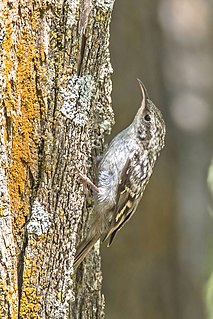
The treecreepers are a family, Certhiidae, of small passerine birds, widespread in wooded regions of the Northern Hemisphere and sub-Saharan Africa. The family contains ten species in two genera, Certhia and Salpornis. Their plumage is dull-coloured, and as their name implies, they climb over the surface of trees in search of food.

The Algarve is the southernmost NUTS II region of continental Portugal. It has an area of 4,997 km2 (1,929 sq mi) with 467,495 permanent inhabitants, and incorporates 16 municipalities.

The spider family Liphistiidae, recognized by Tamerlan Thorell in 1869, comprises 8 genera and about 100 species of medium-sized spiders from Southeast Asia, China, and Japan. They are among the most basal living spiders, belonging to the suborder Mesothelae. In Japan, the Kimura spider is well known.

Faro District is the southernmost district of Portugal, coincident with the Algarve region. The administrative centre, or district capital, is the city of Faro.

Scaffold web spiders (Nesticidae) is a family of araneomorph spiders closely allied with tangle web spiders. Like the "Theridiidae", these spiders have a comb of serrated bristles on the hind tarsi that are used to pull silk bands from the spinnerets. It contains 16 genera and about 300 species, many of which are associated with caves or overhangs. The genus Nesticus is the type for the family and is found throughout the world. The related Eidmannella has speciated considerably in Texas caves and includes some extremely localized species that are considered threatened. One species, Eidmannella pallida, is found in caves and under overhangs, but also in agricultural fields and other habitats away from such restricted areas. The genus Carpathonesticus is found in central Eurasia.

Troglofauna are small cave-dwelling animals that have adapted to their dark surroundings. Troglofauna and stygofauna are the two types of subterranean fauna. Both are associated with subterranean environments – troglofauna are associated with caves and spaces above the water table and stygofauna with water. Troglofaunal species include spiders, insects, myriapods and others. Some troglofauna live permanently underground and cannot survive outside the cave environment. Troglofauna adaptations and characteristics include a heightened sense of hearing, touch and smell. Loss of under-used senses is apparent in the lack of pigmentation as well as eyesight in most troglofauna. Troglofauna insects may exhibit a lack of wings and longer appendages.

Vilamoura is a part of the Loulé municipality in Algarve, on the southern coast of Portugal. It is one of the three corners of Algarve's Golden Triangle. Vilamoura comprises one of the largest single tourist complexes in Europe and with about 2,000 hectares of land. The nearest airport is in Faro.
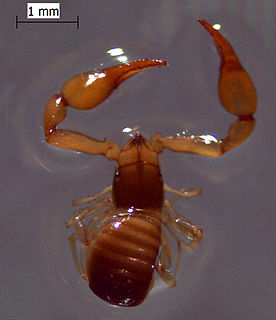
The Chthonioidea are a superfamily of pseudoscorpions, representing the earliest diverging and most primitive living pseudoscorpions. The superfamily contains two families.
The Empire Cave Pseudoscorpion is a species of arachnid in family Neobisiidae. Fissilicreagris imperialis is endemic to Empire, Dolloff, and IXL caves in Cave Gulch, Santa Cruz County, California. It may occur in one or more of the other caves in Cave Gulch, but it is certainly restricted to this small, isolated karst area. Its habitat is threatened by groups of students who come to the cave to drink and party, and possibly by the clean-up efforts that follow.
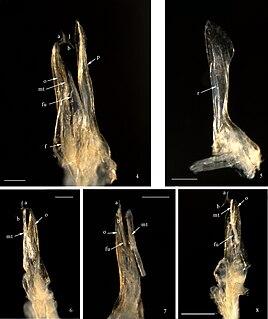
Mammamia profuga is a species of cave-dwelling millipede in the family Julidae. The only known species of the genus Mammamia, it was described in 2011 from a specimen discovered in a cave in Italy.

Movile Cave is a cave near Mangalia, Constanța County, Romania discovered in 1986 by Cristian Lascu a few kilometers from the Black Sea coast. It is notable for its unique groundwater ecosystem abundant in hydrogen sulfide and carbon dioxide, but low in oxygen. Life in the cave has been separated from the outside for the past 5.5 million years and it is based completely on chemosynthesis rather than photosynthesis.
Bochicidae is a family of pseudoscorpions distributed throughout the Americas from Texas and Mexico to South America, from the Antilles to Venezuela, Guyana and Brazil, as well as in Europe. Members of the family can be diagnosed mainly by features of the claws, notably the presence of exactly 12 trichobothria on each claw and a long, as opposed to short, venom duct. Some species live in caves while some are surface-dwelling.
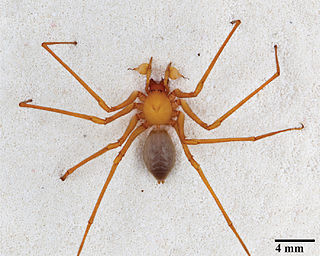
Trogloraptor is a genus of large spiders found in the caves of southwestern Oregon. It is the sole genus in the family Trogloraptoridae, and includes only one species, Trogloraptor marchingtoni. These spiders are predominantly yellow-brown in color with a maximum leg span of 3 in (7.6 cm). They are remarkable for having hook-like claws on the raptorial last segments of their legs.

Neobisiidae is a family of pseudoscorpions distributed throughout Africa, the Americas and Eurasia and consist of 550 species in 32 genera. Some species live in caves while some are surface-dwelling.
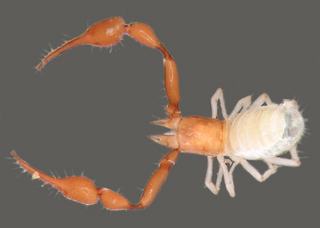
Lusoblothrus is a genus of pseudoscorpions in the family Syarinidae. The genus was created to accommodate its sole species, Lusoblothrus aenigmaticus. The species was recently discovered in Portugal, its description published in 2012.
Chitrella regina is a species of pseudoscorpions in the family Syarinidae.















